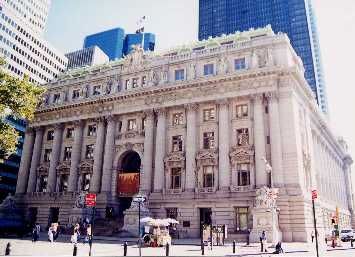 On my trip to New York City last September, I visited two museums featuring Native Americans. Both succeeded in their own way. The following are one man's opinions:
On my trip to New York City last September, I visited two museums featuring Native Americans. Both succeeded in their own way. The following are one man's opinions: On my trip to New York City last September, I visited two museums featuring Native Americans. Both succeeded in their own way. The following are one man's opinions:
On my trip to New York City last September, I visited two museums featuring Native Americans. Both succeeded in their own way. The following are one man's opinions:
The National Museum of the American Indian
While the Smithsonian raises the NMAI building in Washington DC, the 10th museum on the Mall, its Native collection resides in NYC. It's located in the US Customs House on the southern tip of Manhattan. The building itself is a Neo-classical gem, with an equally impressive rotunda, and well worth a look if you're in the area. (More on the building's exterior in a moment.)
The collection on display is relatively small and unimposing. Where the NMAI excels is in giving Native people a voice. Whether it's via placard or video, each artifact is put into context by someone who knows it. It's one thing for a curator to intone that an item is important, and another for the people who used the item (or something like it) to say why it's important. How it connects to their feelings and beliefs.
Also not to be missed are the statues in front of the Customs House representing the four biggest continents. These reinforce the turn-of-the-century stereotypes of when they were created. Naturally, the North America and Europe figures sit proudly erect, looking forward with confidence.
Meanwhile, the Asia figure is regally impassive, remote from worldly concerns. No doubt the sculptor would've been surprised to learn Japan and Hong Kong have become economic powerhouses. And the Africa figure is slumped in his seat, lost in despair. It's Africa as the "dark continent," shrouded in somber mystery.
The American Museum of Natural History
Facing the midpoint of Central Park, the AMNH has extensive displays of the world's people. The world's indigenous or "primitive" people, that is—you won't find any stock brokers, computer programmers, or comic book publishers here.
Fortunately, these displays are mostly excellent. They enliven artifacts with drawings showing how they were used, and clothing by draping it on realistic mannequins. Dioramas give a sense of how people worked and lived together.
The most impressive hall is the one on Northwest Indians. Not only does it have an array of masks and other artifacts, but the hall itself is spectacular. A rectangle with posts carved like totem poles, wood-paneled and dimly lit, the hall makes you feel you've stepped into a Kwakiutl longhouse. This is the way to make Native cultures come alive (museum curators, take note).
Of course, the museum's overall message—that Native cultures are part of the past—is unfortunate. Another faux pas is positioning the Indian halls next to those displaying monkeys and apes. For the politically astute, not to mention the politically correct, the implication is painfully clear.
More on Indians as natural history
Tlingit canoe = natural history?
Related links
A similar look at Los Angeles's museums
The feel-good national museum: reviews of the National Museum of the American Indian
Best Indian monuments to topple
Photographs of Indian country
|
. . . |

|
All material © copyright its original owners, except where noted.
Original text and pictures © copyright 2007 by Robert Schmidt.
Copyrighted material is posted under the Fair Use provision of the Copyright Act,
which allows copying for nonprofit educational uses including criticism and commentary.
Comments sent to the publisher become the property of Blue Corn Comics
and may be used in other postings without permission.